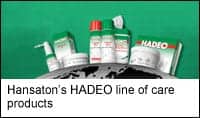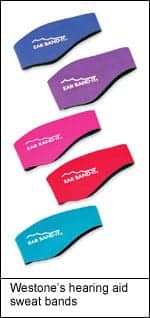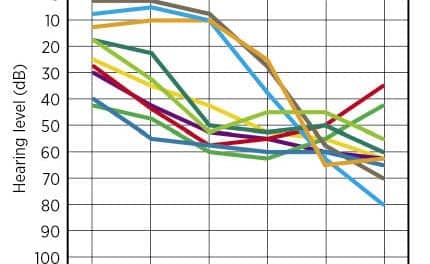Experts from Ear Technology Corp, Oaktree Products Inc, Hansaton Hearing Systems, and Westone Laboratories Inc discuss the products and how-tos of hearing instrument care.

When equipment is expensive, as some hearing aid systems can be, users expect to perform less preventive care. “Yet if a patient bought a BMW or a Jaguar, they would still expect to change the oil,” says Katy Pindzola, director of marketing and operations for Ear Technology Corp, Johnson City, Tenn. “Just because something is more expensive doesn’t mean it takes care of itself.”
Richard Anesko, MS, FAAA, staff audiologist with Westone Laboratories Inc, Colorado Springs, Colo, concurs. “Other patients seem to assume that the relatively high cost of hearing instruments equates to high durability, thus requiring little—if any—instrument maintenance on their part,” Anesko says.
But contrary to this myth, hearing aids require daily care, no matter how expensive the device. “It is critical for hearing instruments to be cleaned of debris on a daily basis,” says A.U. Bankaitis, PhD, FAAA, vice president and general manager of Oaktree Products Inc, St Louis.
| Pass It On “In general, audiologists do a very good job educating patients on hearing instrument care,” says A.U. Bankaitis, PhD, FAAA, vice president and general manager of Oaktree Products Inc, St Louis. This is, in part, selfishly motivated, since an instrument that is well cared for will perform better and result in happier patients. However, users still make some common errors, including not cleaning their equipment at all. “You can break this group into two categories: those unable to keep up with their hearing instrument maintenance and those unwilling to do so,” says Richard Anesko, MS, FAAA, staff audiologist at Westone Laboratories Inc, Colorado Springs, Colo. How to turn their attitude around? Following are 10 tips to assist audiologists and their patients with cleaning compliance: 2. Explain the need for proper care of hearing instruments. Anesko suggests using the analogy of a miniature computer—the digital hearing aid—working in an inhospitable environment, the warm, moist, waxy ear canal. 3. Demonstrate the proper daily care tasks. 4. Have the user show they can perform the maintenance. 5. If the patient is unable to handle the care, work with a caregiver. 6. Suggest that the patient perform daily cleaning in the morning, after the cerumen has had a chance to dry overnight and is easier to remove. 7. Caution users not to clean hearing instruments with alcohol. It denatures rubber, plastic, silicone, and acrylic, common materials in these devices, making them brittle; it also does not provide the same germicidal capabilities as hospital-grade disinfectants. 8. Remind users to maintain the hearing instrument care equipment; for instance, replace the silica pillow in a desiccant system when necessary. 9. Suggest users bring the device in for regular check-ups. 10. And, of course, maintain a full line of hearing care products to meet user maintenance needs. |
A variety of products exist to help users keep their hearing aids clean and therefore maximize the performance and life of the instruments, as well as benefit ear health. Often they are available from the audiologist who has fit the instrument. Their inclusion in a practice assures that the audiologist serves as one resource for a patient’s hearing aid needs.
“It is in the professional’s own interest to sell care products, not only to increase customer satisfaction but also to bring customers in on a regular basis,” says Raymond Nibbe, new business manager for Hansaton Hearing Systems, Hamburg, Germany, with US headquarters in Tampa, Fla.
Hearing instrument care products provide an opportunity for audiology professionals to broaden their product lines. “In some outlets in Europe, already 25% to 30% of the total turnover of a retail outlet is made with accessories such as cleaning and care products, batteries, etc,” Nibbe says.

|

|

|
The Dirt on Hearing Care
“Hearing instruments are relatively small devices comprised of electronic components easily exposed to dirt, oil, moisture, and cerumen that can impair hearing instrument performance. For example, cerumen can easily clog the hearing instrument receiver, causing feedback or completely blocking incoming sound,” Bankaitis says.
Whether a hearing instrument is a CIC, ITC, ITE, or BTE device, debris, wax, and moisture can reduce performance or cause a failure, sometimes as quickly as within a few weeks. “A hearing instrument receiver, clogged by cerumen and other debris, will become weak or cut out completely. Likewise, any debris on the instrument’s microphone(s) can reduce sensitivity and/or directional response. Moisture also may seep into the inner electronics, causing corrosion, and may ultimately lead to component failure,” Anesko says.
Anesko suggests that BTE devices tend to have fewer maintenance-related problems as a result of cerumen-related component features. “A BTE, utilizing a custom earpiece, is immune to damage or failure related to wax getting into the receiver housing. There are no internal components to damage during cleaning, and the earpiece usually can be removed from the hearing instrument and soaked in warm soapy water for a more thorough cleaning,” Anesko says.
Digital instruments still have analog inputs and outputs and are subject to damage, according to Pindzola. She suggests the microphone is prone to moisture issues, as is the receiver, which also can be impacted by cerumen.
Bacteria and fungi are also potential problems. “Research has shown that various bacterial and fungal growth accumulates on hearing instrument surfaces, some of which is not considered part of the normal ear canal flora,” Bankaitis says.
Pindzola suggests itchy ears actually may be due to a subclinical level of micro-organisms residing within the pores of the hearing instrument, rather than an allergy to the plastic, a common diagnosis.
Wax On, Wax Off
To address these issues, companies offer a range of care products from wipes and brushes to devices that use heat, germicidal lamps, and desiccants to clean and dry hearing instruments. Whatever process a user chooses, it is typically required daily, although most processes do not take much time.
“Generally, there is a visual inspection, and the user wipes the instrument off using a cloth or tissue, then removes debris from the microphone with a brush, and finally clears the receiver of debris using a brush, wax loop, or pick. The entire process takes about 2 to 3 minutes,” Anesko says.
For the hearing aid professional—and occasionally, the savvy hearing instrument user—Westone offers three models of instrument cleaning vacuums, which are used to remove cerumen and debris from the receiver and vent bores.
Hansaton offers a range of care products for cleaning as well. Its HADEO line features tabs, tissues, concentrate and liquid disinfectants, sprays, and a cleaning cup; the latter is designed for use with the tabs and cleaning liquid to remove debris from ear molds and sound tubes.
“The HADEO range of products covers all aspects of caring for and cleaning hearing instruments—BTE/ITE, ear molds, tubing, open tubes, etc. The products are available in single form or in handy sets, eg, cleaning set, drying set, sets for BTEs or ITEs, etc,” Nibbe says.
One of the first products introduced by Oaktree is the Audiologist’s Choice Earwax Removal Product, which is sold singly as softening solution or as part of an earwax removal kit. Though sold over the counter, both are ideally designed for use by an audiologist.

Audiologist’s Choice AudioWipes allow users to wipe an instrument and disinfect it at the same time. The wipes incorporate a nonalcohol cleanser, which does not denature rubber, plastic, silicone, or acrylic, as alcohol does. The Audiologist’s Choice line of disinfectants also includes a spray hard surface disinfectant, ultrasonic disinfectant concentrate, and ear mold and ITE disinfectant cleaner; the latter is available in smaller sizes for at-home use.
For at-home cerumen removal, Westone’s Anesko recommends careful morning cleanings as well as preventive guards. “Earwax is drier, flakier, and easier to remove once the unit is out of the person’s ear. At night, when the instrument is taken out of the ear, the wax is damp, moist, sticky, and difficult to remove,” he says.
For CIC devices, which are more susceptible to cerumen, Anesko recommends guards. “Most manufacturers have some sort of cerumen protection system, but some people like an added layer of protection,” he says. For these patients, Westone offers the Ad-hear and Ad-hear Plus Cerumen Guards, which are disposable cloth filters designed to keep cerumen out while letting sound through.
Staying Dry
Preventive guards, such as those designed for BTE devices, also can protect instruments from moisture. Westone offers the Hearing Aid Sweat Band, which resembles a little sock sized to fit the small devices.
Unfortunately, many moisture issues are unavoidable. “The user may reside in a very humid climate or be very active, resulting in profuse perspiration. There are solutions available for almost any obstacle to keeping hearing instruments in top working condition,” Oaktree’s Bankaitis says.

|

|

|

|

|
Dehumidifiers can use desiccants, air, electric heat, or some combination of these methods to dry hearing instruments.
Ear Technology Corp’s flagship product is the Dry & Store dehumidifier, which incorporates a 4-watt germicidal UV lamp, circulated electric heat, and a custom-formulated desiccant to dry and sanitize hearing instruments. According to the company, the Dry & Store’s germicidal lamp kills 99.9% of bacteria. The system is recommended for nightly use to allow its full 8-hour cycle to run, although Pindzola notes that some patients also use it for shorter periods, such as during showers and naps, and after sweaty activities. Pindzola also notes that it can be used by audiologists during trouble-shooting.
The device is designed for easy use by children as well as patients with manual dexterity or vision impairment. Patients place their hearing instruments in the drawer and simply push the start button. “The germicidal lamp kills the germs residing in the plastic. And the desiccant not only captures moisture but also odor. So people have a fresh hearing instrument in the morning, which improves the hearing aid experience,” Pindzola says, adding that it also improves the hearing aid’s life.
Ear Technology Corp sells the product through hearing care professionals and distributors, such as Oaktree, Westone, and others. The system also is shipped with every cochlear implant system from all Cochlear™ facilities.
Hansaton’s HADEO line includes the Airball, which blows air to remove moisture; the Dry Cup, which uses a desiccant to dry hearing instruments within the sealed cup overnight; and the Drybox, which uses electric heat to dry BTE and ITE systems.
One of Hansaton’s newest products is the Ultrasonic-Cleaner, which uses ultrasound waves to clean and dry instruments. The company also expects that the charging portion of its new battery rechargeable system, which will be launched as the AQ, will serve to dry components as a result of the heat generated by the device.
The range in products available to professionals and consumers accommodates users’ varying budgets and tastes. For instance, Westone offers the Moisture Guard hearing instrument dryer, made from cherry wood and resembling a jewelry box, as well as a 15-inch stuffed toy called Mr BTE that contains a dehumidifier.
The Audiologist’s Choice dehumidifiers by Oaktree come in different models, including the Dry Spot dehumidifier, which resembles a crystal-like container, and the Ducks or Fish dehumidifiers with containers that display classic duck decoys or brightly colored tropical fish, respectively. “The containers are microwave safe and are intended for use by the patient at home, preferably each night,” Bankaitis says.
Care Package as Value Package
Pindzola believes customers understand the value of hearing instrument care products when they are no longer forced to choose between hearing and their favorite activities. She recounts the story of a woman who removed her hearing aid while hiking due to the negative impact of sweat, as well as that of a mother who purchased two processors for her son’s cochlear implant to swap midday after the first failed as a result of sweat. “With Dry & Store, they told me they no longer had to do that,” Pindzola says.
Care products allow hearing instrument users to maintain their lifestyles. Regular care can prolong the life of the instrument, maximize performance, and minimize lengthy repairs. Inadequate care will result in failure.
“Of course, the patient’s only concern is that the hearing instrument they rely on for improved communications is now out of commission. It really makes no difference what caused the hearing instrument to fail,” Anesko says. However, he notes that the hearing care professional and the vendor want the customer to be satisfied. “More satisfied patients should equate to more referrals of family and friends, as well as repeat business when it does come time to replace the hearing instruments,” Anesko says.
It is, therefore, in the interest of the audiologist to offer products directly to patients for the care and maintenance of their hearing instruments. Bankaitis says, “It provides the opportunity to strongly communicate to patients that as their audiologist, you are the resource for all of their hearing health care needs.”
Renee Diiulio is a contributing writer for Hearing Products Report. For more information, contact [email protected].





